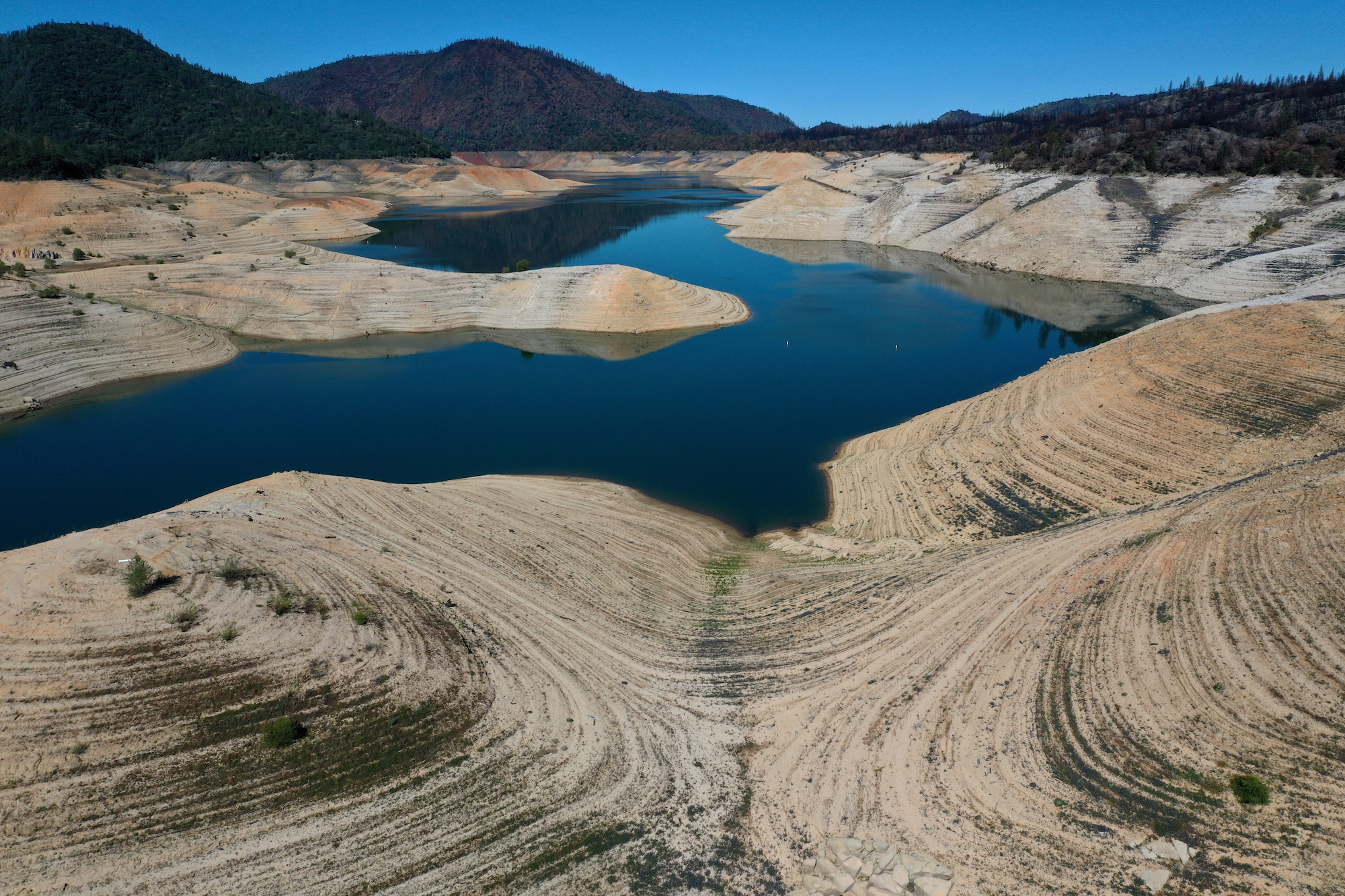From a rise overlooking the unusually low San Luis Reservoir, California Governor Gavin Newsom declared a drought emergency for 39 of the state’s 58 counties on Monday. This was the second stop on his dry lake tour: Less than a month earlier, Newsom had stood on the cracked bottom of Lake Mendocino, a spot normally 20-feet underwater, and announced a drought emergency in Sonoma and Mendocino counties. Not far from where he spoke in April, an early wildfire raged, where spring grasses had prematurely yellowed to tinder.
“That’s unprecedented for this time of year, said Grant Davis, general manager of Sonoma Water, who spoke at the same lectern as Newsom that day. “We’ve had big fires three out of the last five years. Believe me this is climate change and extreme weather all rolled into one.”
As California’s not-so-wet season draws to a close, half the state is already in ‘extreme drought.’ That means that thousands of wells could go dry in the poorest rural areas in the coming months, and fish populations will suffer as rivers heat up. In the northern half of the state, reservoir levels are already as low as they were three years into the last major drought that ran from 2011 to 2017. But California emerged from that long spate of dry weather with hard-won skills that make it better prepared this time around.
The entire West has suffered from droughts in recent years, but there’s something that captures the public imagination when disaster hits California, the most populous state, that promised land of sunshine, fruit trees, and celluloid dreams. Whenever drought grips California, elements of the media fall into an ecstatic doom loop, producing headlines that make the state sound like an apocalyptic wasteland.
In some ways, things are definitely bad: The state has entered an era of consistent water scarcity and consistently higher temperatures. The last three California droughts have been among the driest, and also the warmest, on record. The little increase in temperatures has been disastrous, melting away snowpack, drying up soils, and exacerbating forest fires.
Source: NOAA Dashed lines indicate 1901–2021 trends. Clayton Aldern / Grist
At the same time, California is adapting. Davis and other speakers at a presentation by the Public Policy Institute of California didn’t downplay the severity of the drought, but they also said officials were more prepared than in the past. “We have done a lot since the last drought, and we are in a much better position now,” said Alvar Escriva-Bou, a water research fellow at the institute.
Previous droughts spurred cities to invest in backup pipelines and wells. Some cities in the driest parts of the state — like in Mendocino and Sonoma — are beginning to ask residents to conserve but in general, Escriva-Bou said, “Cities shouldn’t see big impacts this time.”
It’s a different story in the rural parts of California: Escriva-Bou has projected that 2,400 wells could go dry around the state this year. That’s grim, but the fact that anyone is making those projections is an improvement over the last drought, when some 3,000 wells went dry without warning. “Now we know where they are and can be proactive,” he said.
State agencies have begun contacting communities that rely on shallow wells to help them find backups. If those preparations fail, California is ready to sweep in with emergency water supplies, said Laurel Firestone, a member of the California State Water Board. “We don’t want to be trucking water to houses or trucking fish to water,” she said. “Those are emergencies we want to do everything to avoid.”
Still, California is already making plans to move some fish in tanker trucks. Normally fish hatcheries release salmon into rivers, but this year those rivers are too low, and the water is too warm. So this year, instead of swimming downstream, the salmon will travel by truck to the Pacific Ocean.
California has also adapted by building better weather forecasting tools. In the past, water managers would open up dam spillways as big storms approached to make enough room in reservoirs to catch floods and protect towns downstreams. Errant forecasts often made a mess of the situation: The storm would turn off the projected course, leaving water managers with depleted reservoirs. The improved forecasting techniques this year have allowed water managers to hold onto an extra 3.5 billion gallons of water in Lake Mendocino, nearly a third of its remaining water, Davis said.
On Monday, Newsom vowed to spend $5 billion to improve California’s water systems and said the state had already made strides since the last drought. “Not only are we more prepared in terms of expertise and insight, but also by nature of the fact that 16 percent less water is being used in this state compared to the first drought proclamation last time,” he said.
Just a few short years ago, policy wonks were still arguing over whether governments should spend money on adapting to climate change, like preparing for droughts, or on efforts to prevent climate disasters from happening in the first place. Those debates seem quaint now.



